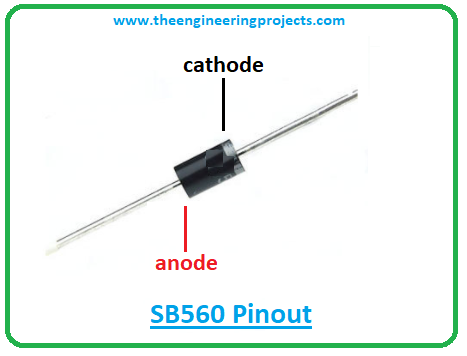 Hi Friends! Hope you’re well today. I welcome you on board. Thank you for clicking this read. In this post today, I’ll detail the Introduction to SB560.
Hi Friends! Hope you’re well today. I welcome you on board. Thank you for clicking this read. In this post today, I’ll detail the Introduction to SB560.
The SB560 is a Schottky diode, also known as a hot-carrier diode, mainly incorporated in extremely fast switching applications. It comes with low forward drop voltage and is used in the high-frequency operation. A highly reliable and efficient device, SB560 is a high forward surge capability component available in the DO-201AD package. This device carries a maximum RMS voltage of 42V while the maximum repetitive peak reverse voltage is 60V.
I suggest you go through this entire post till the end, as I’ll detail the Introduction to SB560 covering datasheet, pinout, features, and applications.
Let’s jump right in.
Introduction to SB560
- The SB560 is a Schottky diode used in extremely fast switching applications. It is also known as a hot-carrier diode.
- When semiconductor material combines with the metal, they generate Schottky diode. This diode is a two-terminal device where these terminals are used for the external connection with the circuit.
- One terminal is known as anode made of metal material while the other terminal is called cathode made of semiconductor material.
- The anode side is positive while the cathode side is negative. And current only flows in one direction. This diode blocks the current in the opposite direction. The current flows from the anode pin to the cathode pin.
- This Schottky diode is also known as a hot-carrier diode. In an unbiased condition, this device possesses low electronic energy that results in the construction of a barrier that restricts the movement of electrons. Due to the formation of this barrier, Schottky diodes are also called hot-carrier diodes.
- Schottky diode and common diode operate in a similar fashion considering the flow of current. Both favor current flow in one direction and restrict the current flow in another direction. These devices are different considering the voltage required to power up these diodes.
- Though both devices require 2V DC source voltage, the Schottky diode needs only 0.3V, leaving behind 1.7V to supply power to the diode. While common diode needs only 0.7V, leaving behind 0.3V to supply power to the diode.
SB560 Datasheet
While working with the electrical devices, it’s better to go through the datasheet of the component that details the main characteristics of the component.
You can easily download the datasheet of this component SB560 by clicking the link below.
SB560 Pinout
The following figure shows the pinout diagram of SB560.
The SB560 is made of two terminals called anode and cathode. The anode side is positive while the cathode side is negative. Current flows from the anode terminal to the cathode terminal.
SB560 Features
- Applied for over-voltage protection
- High current capability device
- High surge current capability device
- Polarity = Cathode band
- average forward rectified current = 5A
- Package = DO-201AD
- Maximum RMS voltage = 42V
- Mounting position = Any
- Repetitive peak reverse voltage = 60V
- Comes with low forward voltage drop
- Low power loss and highly efficient device
- Low cost and high-reliability device
SB560 Schottky Diode Construction
- Schottky diode is formed when the semiconductor material is joined with metals like tungsten, platinum, chromium, and molybdenum.
- When these two materials are joined they constitute a barrier that blocks the movement of electrons.
- Recall, the formation of a barrier is due to the low electronic energy in the unbiased condition.
- Commonly, the n-type semiconductor material is used to form the Schottky diode.
- P-type semiconductor materials are also used for making the Schottky diode but they are not preferred over n-type semiconductor materials because the former comes with low forward drop voltage.
- The anode side of the diode is composed of metal while the cathode side is made of semiconductor material. And current flows from the positive anode side to the negative cathode side.
SB560 Applications
- Used in low voltage inverters and DC/DC converters.
- Used to control the electronic charge.
- Used in freewheeling and logic circuits.
- Used for signal detection.
- Used in polarity protection and high-frequency applications.
- Used in sample-and-hold circuits.
- Used in solar systems and radio frequency applications.
- Used for extremely fast switching applications.
That was all about the Introduction to SB560. I hope you find this article useful. If you’re unsure or have any question, you can ask me in the comment section below, I’d love to help you the best way I can. You’re most welcome to share your valuable suggestions around the content we share so we keep producing quality content. Thank you for reading the article.
JLCPCB – Prototype 10 PCBs for $2 (For Any Color)
China’s Largest PCB Prototype Enterprise, 600,000+ Customers & 10,000+ Online Orders Daily
How to Get PCB Cash Coupon from JLCPCB: https://bit.ly/2GMCH9w
The post SB560 Schottky Diode Datasheet, Pinout, Features & Applications appeared first on The Engineering Projects.

No comments:
Post a Comment